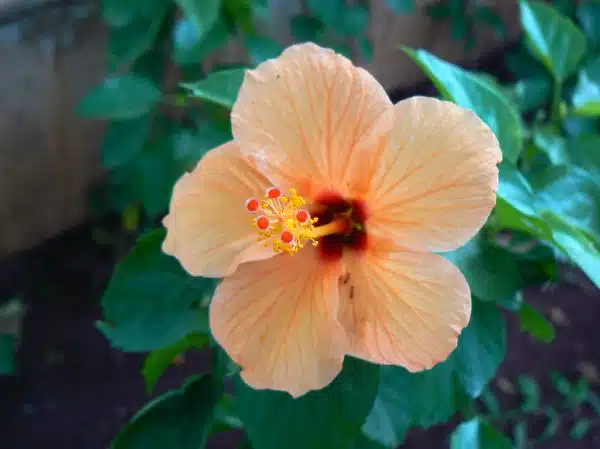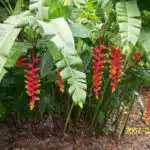Tropical hibiscus plants are known for their vibrant and colorful flowers, making them a popular choice for gardeners who want to add a touch of exotic beauty to their homes. However, growing these plants indoors can be quite challenging as they require specific conditions to thrive. As a horticultural expert, I have observed that many people struggle with growing tropical hibiscus plants inside their homes due to various factors such as insufficient light, water or humidity levels.
To successfully grow tropical hibiscus indoors, it is important to understand the needs and requirements of these plants. From choosing the right potting mix to providing the optimal amount of sunlight and watering schedules, there are several factors that must be considered when cultivating these beautiful flowering plants. In this article, we will explore the essential tips and techniques that you need to know in order to grow healthy and stunning tropical hibiscus plants inside your home. Whether you are a seasoned gardener or a beginner looking to try your hand at indoor gardening, this guide will provide you with all the information you need to succeed in growing tropical hibiscus plants indoors.
Understanding Tropical Hibiscus Plants
Tropical hibiscus plants are a popular choice for indoor gardening due to their vibrant blooms and easy care requirements. Understanding the proper growing conditions is essential for ensuring that these plants thrive in an indoor environment. One of the most critical aspects of growing tropical hibiscus is soil quality. These plants require well-draining soil with a pH range between 6.0 and 7.0, which can be achieved by mixing standard potting soil with perlite or coarse sand.
Pruning techniques also play a vital role in maintaining the health and appearance of tropical hibiscus plants. Regular pruning helps to stimulate new growth, remove dead or damaged branches, and control the plant’s size and shape. The best time to prune tropical hibiscus is during its dormant period in late winter or early spring when growth is minimal. Pruning should be done using sharp, clean shears, making cuts just above leaf nodes.
To ensure successful indoor cultivation, it’s crucial to choose the right variety of tropical hibiscus plant for your growing conditions. Factors such as light levels, humidity preferences, and temperature requirements vary among different types of hibiscus plants. When selecting a variety for indoor growing, consider factors such as available space, desired bloom color and size, and your ability to provide appropriate care requirements. With proper understanding of soil quality and pruning techniques along with careful variety selection, you can create a stunning tropical oasis inside your home.
Choosing The Right Variety For Indoor Growing
While tropical hibiscus plants are generally associated with outdoor gardens and landscapes, they can also be grown indoors with the right care and attention. One of the key factors to consider when growing hibiscus indoors is lighting. These plants require bright and indirect light, so it’s important to place them near a window that receives plenty of sunlight. Alternatively, artificial light sources such as fluorescent or LED lights can also be used to provide adequate illumination.
Aside from lighting, temperature control is another crucial element for successfully growing tropical hibiscus indoors. These plants prefer warm temperatures between 60-65°F (15-18°C) at night and 70-75°F (21-24°C) during the day. Avoid placing them in drafty areas or near heating/cooling vents that could cause fluctuations in temperature. Regularly monitoring indoor temperatures and making necessary adjustments can help ensure optimal growing conditions for your hibiscus plant.
Overall, growing tropical hibiscus plants inside requires careful consideration of both lighting and temperature control. With proper attention given to these elements, you can create an environment that promotes healthy growth for your hibiscus plant. In the next section, we will explore how selecting the ideal potting mix is crucial to maintaining strong roots and supporting overall plant growth.
Selecting The Ideal Potting Mix
Organic soil is a good choice for growing tropical hibiscus indoors because it contains essential nutrients for optimal root development. Potting soil mixes are a good option for growing tropical hibiscus indoors because they retain moisture and provide a suitable environment for the plant. When selecting a potting soil mix for tropical hibiscus, it is important to ensure it contains organic material such as peat moss, compost, and perlite for better drainage and aeration. Additionally, the mix should be pH balanced and contain slow-release fertilizers for sustained plant growth.
Organic Soil
Organic soil is a popular choice among hibiscus growers because of its numerous benefits. Unlike synthetic soil, organic soil is made from natural materials such as compost and decomposed plant matter. This means that it contains a diverse range of microorganisms that promote healthy root growth and improve nutrient uptake. Organic soil also has a more balanced pH level compared to synthetic soil, which can be too acidic or alkaline for some plants.
Soil pH is an important factor to consider when selecting the ideal potting mix for your tropical hibiscus. These plants prefer slightly acidic soil with a pH between 6.0 and 6.5. Organic soil tends to have a more neutral pH level that can be adjusted by adding acidic or alkaline amendments such as sulfur or lime. It’s important to maintain the correct pH level in your potting mix as it affects the availability of nutrients in the soil.
Nutrient balance is another key consideration when choosing between organic and synthetic soil for your hibiscus plants. While synthetic fertilizers provide instant nutrients, they lack the diversity of micronutrients found in organic soil. Organic soil has a more complex nutrient profile that supports long-term plant health and reduces the risk of nutrient imbalances or deficiencies. Additionally, organic fertilizers release nutrients slowly over time, reducing the risk of fertilizer burn or damage to delicate roots.
In conclusion, selecting the ideal potting mix for your tropical hibiscus requires careful consideration of factors such as soil type, pH level, and nutrient balance. Organic soil offers numerous benefits over synthetic alternatives including improved microbiome diversity, balanced pH levels, and complex nutrient profiles that support long-term plant health. By choosing an organic potting mix that meets these requirements, you’ll give your hibiscus plants the best possible chance to thrive and bloom beautifully year after year.
Potting Soil Mix
When it comes to selecting the ideal potting mix for your tropical hibiscus, one of the most important factors to consider is the soil mix. The right potting soil mix should provide adequate moisture retention, as well as a balanced pH level and nutrient profile that support healthy plant growth. While there are many different types of potting soils available on the market, organic alternatives are often preferred by hibiscus growers due to their numerous benefits.
One advantage of organic potting mixes is their ability to retain moisture more effectively than synthetic alternatives. This is because organic soil contains a higher percentage of humus, which can hold up to 90% of its weight in water. By contrast, synthetic soils tend to be less absorbent and may require more frequent watering as a result. Additionally, organic potting mixes often contain natural additives such as perlite or vermiculite that improve drainage and prevent waterlogging.
Another benefit of using organic potting mixes for your hibiscus plants is their ability to promote long-term plant health through a balanced nutrient profile. Unlike synthetic fertilizers that provide a quick burst of nutrients, organic fertilizers release nutrients slowly over time, providing a sustained source of nourishment for your plants. Additionally, organic soil tends to contain a wider range of micronutrients such as iron and manganese that support healthy root growth and improve overall plant vigor. By choosing an organic potting mix that meets these requirements, you can give your hibiscus plants the best possible chance for success in your home garden or greenhouse.
Providing Adequate Drainage
Adequate drainage is crucial when growing tropical hibiscus indoors. These plants require well-draining soil and containers that allow excess water to escape easily. Using appropriate containers is important for ensuring proper drainage. Avoid using containers without drainage holes or those that are too small, as this can lead to overwatering and root rot.
To ensure proper drainage, use a potting mix designed specifically for tropical plants that contains perlite or vermiculite. These materials help to aerate the soil and prevent compaction. When planting your hibiscus, make sure the container has drainage holes at the bottom to allow excess water to escape. If you cannot find a suitable container with drainage holes, drill some yourself.
Overwatering can be a common problem when growing tropical hibiscus indoors, so it’s essential to avoid this by watering only when necessary. Check the soil moisture level by inserting your finger into the soil up to the second knuckle; if it feels dry at this depth, it’s time to water. Water thoroughly until it drains out of the bottom of the pot, then discard any excess water from the saucer below. Remember, more plants die from overwatering than underwatering.
Proper drainage is essential when growing tropical hibiscus indoors, but it’s not enough on its own. Ensuring proper sunlight levels is equally crucial for these plants’ health and growth. By providing optimal conditions for your hibiscus plant’s growth and development, you’ll enjoy an abundance of beautiful blooms all year round!
Ensuring Proper Sunlight Levels
Ensuring proper sunlight levels is crucial to growing tropical hibiscus indoors. However, in some cases, natural light may not be sufficient to promote healthy growth and flowering. This is especially true during the winter months when the days are shorter, and the sun’s intensity is weaker. In such situations, it becomes necessary to supplement natural light with artificial grow lights.
Adding supplemental heat can also help boost your hibiscus plant’s growth during colder months. Hibiscus plants prefer daytime temperatures between 68-86°F (20-30°C) and nighttime temperatures between 60-65°F (15-18°C). If your indoor temperature falls below these ranges, using a space heater or warming mat can help maintain optimal temperatures for faster growth.
Another way to maximize the amount of available light for your tropical hibiscus plant is by incorporating reflective surfaces around its vicinity. Mirrors or white walls can reflect natural light onto the plant from different angles, increasing its exposure to sunlight. This simple hack can make a significant difference in promoting healthy foliage and vibrant blooms.
Supplementing light with grow lights is an essential aspect of indoor hibiscus care that should not be overlooked. Grow lights mimic the spectrum of natural sunlight and provide the necessary wavelengths for photosynthesis and flowering. They come in different types, including fluorescent tubes, LED lights, and high-intensity discharge (HID) bulbs. Appropriate placement of grow lights around your hibiscus plant can ensure it receives adequate lighting throughout its growth cycle without relying solely on natural light sources.
Supplementing Light With Grow Lights
Grow lights are a great way to supplement light in a home or office environment, especially for tropical hibiscus. Different types of grow lights are available and should be chosen based on factors such as the size of the growing area, the type of plant being grown, and the amount of light needed. Setting up grow lights is fairly straightforward and is typically done by suspending the lights above the plants, making sure to adjust the distance to the plant based on the type of grow light being used. Additionally, the timer can be used to ensure the plants are receiving the appropriate amount of light.
Types Of Grow Lights
To ensure optimal growth of tropical hibiscus plants indoors, supplementing natural light with grow lights is crucial. When it comes to selecting the right type of grow light for your indoor hibiscus plants, there are two main options: LED and fluorescent. LED grow lights are more energy-efficient and have a longer lifespan compared to fluorescent grow lights. On the other hand, fluorescent grow lights emit less heat and are more affordable than LED lights.
Another important factor to consider when choosing the right grow light for your indoor hibiscus plants is wattage. The wattage of a grow light determines its strength and output intensity. For tropical hibiscus plants, it is recommended to use a minimum of 100 watts per square foot of growing area. However, this may vary depending on the specific species of hibiscus that you are growing and their individual lighting requirements.
Ultimately, when deciding between LED or fluorescent grow lights and determining the appropriate wattage for your indoor hibiscus plants, it’s important to consider your budget, plant needs, and personal preferences. By providing your tropical hibiscus plants with adequate supplemental lighting using the appropriate type and wattage of grow lights, you can ensure optimal growth and beautiful blooms all year round.
Setting Up Grow Lights
Now that we have discussed the importance of supplementing natural light with grow lights and the different types of grow lights available for indoor hibiscus plants, let’s move on to setting up grow lights. If you’re looking to create a DIY grow light setup, there are a few key factors to keep in mind. First, make sure to choose a location that is close enough to an electrical outlet but also provides adequate space for your plants.
When it comes to setting up your actual grow light system, LED grow lights offer several benefits over fluorescent options. LED lights are more energy-efficient, emitting less heat and using less electricity than fluorescent bulbs. Additionally, they have a longer lifespan which can save you money in the long run. To get started with your DIY setup, you’ll need several LED light panels or bulbs depending on the size of your growing area.
It’s important to note that while setting up a grow light system can be relatively simple, there are some precautions to take to ensure optimal growth and safety for both you and your plants. Make sure not to overload electrical outlets or use damaged equipment when setting up your DIY system. Additionally, consider investing in timers or smart plugs so that your plants receive consistent lighting even when you’re not home. By following these guidelines and utilizing the benefits of LED grow lights, you can create an efficient and effective indoor growing environment for your tropical hibiscus plants.
Managing Humidity Levels
Maintaining the proper humidity levels is essential for growing healthy tropical hibiscus plants indoors. The ideal humidity range for these plants is between 50-60%. However, it can be challenging to maintain this level of humidity, especially during the winter months when indoor heating reduces moisture in the air.
Using humidifiers or misters is an effective way to manage humidity levels for tropical hibiscus plants. Humidifiers add moisture to the air and help regulate humidity levels in a room. Mist systems are also beneficial and can be installed directly above your plants, providing them with a constant supply of moisture throughout the day. It is important to monitor the relative humidity regularly using a hygrometer to ensure that it remains within the desired range.
High humidity levels can create a favorable environment for mold growth, which can harm your tropical hibiscus plants. To prevent mold growth, make sure that you are not overwatering your plants and avoid standing water in trays or saucers. Regularly clean any debris or dead plant matter from around your plant’s base and increase airflow by opening windows or using fans in your grow space. By following these simple steps, you can easily manage humidity levels and keep your tropical hibiscus plants healthy and thriving.
Transition: Now that we have discussed managing humidity levels for your tropical hibiscus plants, let us move on to the next important aspect of caring for them – watering techniques.
Watering Your Tropical Hibiscus Plants
After managing the humidity levels, it’s time to focus on watering your tropical hibiscus plants. Water is essential for plant growth, and it is vital to ensure that your plants get the right amount of water. Too much or too little water can affect their health and make them weak. Therefore, you need to be careful about watering frequency and signs of overwatering.
To determine the watering frequency, you should check the soil moisture level first. The best way to do this is by sticking your finger into the soil up to an inch deep. If it feels dry at that depth, then it’s time to water your plant. However, if it’s still moist, wait for a day or two before checking again. It’s important not to let the soil dry out completely as this can damage your plant.
Overwatering is a common problem in tropical hibiscus plants that leads to root rot and fungal diseases. Signs of overwatering include yellowing leaves, wilting foliage, and a foul smell from the soil. To avoid overwatering, make sure that there are proper drainage facilities in place for excess water to drain out of the pot quickly. You can also use a well-draining soil mix and reduce watering frequency during periods of high humidity.
Watering your tropical hibiscus plants requires attention and care to ensure optimal growth. By following these guidelines on watering frequency and signs of overwatering, you can help keep your plants healthy and thriving. In the next section, we will discuss fertilizing for optimal growth – another crucial aspect of growing tropical hibiscus inside.
Fertilizing For Optimal Growth
To ensure that your tropical hibiscus plants thrive, it is essential to provide them with the right nutrients. One way to achieve this is through fertilization. There are two main types of fertilizer: organic and chemical. Organic fertilizers are derived from natural sources, such as animal waste or composted materials, while chemical fertilizers are manufactured using synthetic compounds.
When it comes to choosing between organic and chemical fertilizers for your tropical hibiscus plants, there are pros and cons to both. Organic fertilizers provide a slow-release of nutrients over time, which can lead to more sustainable growth. However, they can also be more expensive than chemical options and may not be as readily available in some areas. Chemical fertilizers, on the other hand, offer a quick boost of nutrients that can promote rapid growth but may not be as environmentally friendly.
The frequency of fertilizing your tropical hibiscus plants depends on several factors such as soil type, plant age, and environmental conditions. As a general rule of thumb, younger plants require more frequent feedings than mature ones. It is important not to over-fertilize your plants as this can lead to nutrient burn or other issues. Always follow the recommended dosage instructions carefully and pay attention to any signs of distress in your plant’s growth or appearance.
Transitioning into pruning and shaping your plants: Now that you have learned about the importance of proper fertilization for optimal growth in your tropical hibiscus plants let’s discuss how pruning and shaping can further enhance its beauty and health.
Pruning And Shaping Your Plants
Pruning and shaping your tropical hibiscus plants is an essential aspect of maintaining their health and beauty. Training techniques can be used to control the size, shape, and direction of your plant’s growth. It is important to note that pruning should never be done during the plant’s blooming period as it can hinder the flowering process.
Decorative pruning is a technique that allows you to sculpt your hibiscus into various shapes or patterns. This method involves removing specific branches or shoots to create a desired form. One popular style is topiary, which involves trimming the foliage into geometric shapes such as balls, cones, or spirals. Another style is espalier, where the branches are trained flat against a wall or fence in a decorative pattern.
When using any training technique or decorative pruning method, it is vital to use proper tools and techniques to avoid damaging the plant. Always make cuts at a 45-degree angle using sharp, clean pruning shears. Also, ensure that you do not remove more than one-third of the plant’s overall growth at any one time.
As you can see, pruning and shaping your tropical hibiscus plants can be both functional and aesthetically pleasing. With proper techniques and care, you can maintain healthy plants with beautiful blooms for years to come. In the next section, we will discuss dealing with pests and diseases that may affect your plants’ health and appearance.
Dealing With Pests And Diseases
As with any plant, tropical hibiscus is susceptible to pests and diseases. Whether you are growing them indoors or outdoors, it’s important to keep an eye out for any signs of trouble. Nothing is more disheartening than watching a plant you’ve nurtured suddenly succumb to infestation or illness.
Fortunately, there are a variety of natural remedies that can be used to combat pests and diseases. For example, neem oil is a popular choice for controlling insect populations. It works by disrupting the life cycle of the insect and preventing it from reproducing. Other natural remedies include garlic spray, which can be effective against aphids and mites, and diatomaceous earth, which acts as a physical barrier against crawling insects.
If natural remedies fail to solve the problem, chemical treatments may be necessary. However, it’s important to use these products sparingly and only when absolutely necessary. Overuse of chemicals can harm beneficial insects as well as the plant itself. Always follow package instructions carefully and dispose of unused chemicals properly. Remember that prevention is always better than cure – keeping your plants healthy and well-cared-for will go a long way in preventing pest and disease problems from arising in the first place.
Moving on from pest control, propagating tropical hibiscus plants can be an enjoyable way to expand your collection or share your love of gardening with friends and family. But where do you start? In the next section, we’ll explore some of the best techniques for propagating tropical hibiscus plants – no green thumb required!
Propagating Tropical Hibiscus Plants
Propagation Techniques for Tropical Hibiscus Plants
Plant care is an important aspect of growing tropical hibiscus plants, and propagation plays a vital role in maintaining their health and vigor. Propagation is the process of creating new plants from existing ones, and there are different techniques that can be used to propagate tropical hibiscus plants. The most common methods include stem cuttings, air layering, and seed propagation.
Stem cuttings are one of the easiest and most popular ways to propagate tropical hibiscus plants. To do this, select a healthy stem from the parent plant and make a clean cut just below a leaf node. Remove all but the top few leaves and dip the cutting into rooting hormone before planting it in a well-draining potting mix. Keep the soil moist and warm until roots form, usually in about four to six weeks.
Air layering involves creating a new plant by encouraging roots to grow on a portion of the stem while still attached to the parent plant. This method requires more time and effort than stem cuttings but can produce larger plants with established root systems. To air layer a tropical hibiscus plant, select a healthy stem and make an upward cut about 1/3 of the way through. Place moist sphagnum moss around the cut area and cover it with plastic wrap to create a humid environment. After several weeks, roots will start to form on the moss-covered section of stem, which can then be removed from the parent plant and planted separately.
In summary, propagating tropical hibiscus plants is an essential part of caring for these beautiful flowers. By using different propagation techniques such as stem cuttings or air layering, gardeners can create new plants that are genetically identical to their parent plant or even develop new varieties through seed propagation. With some patience and care, anyone can propagate tropical hibiscus plants successfully!
When it comes to growing tropical hibiscus plants indoors, creating a suitable environment is crucial for their health and growth. The next section will discuss the essential factors to consider when growing tropical hibiscus inside and how to create an optimal indoor environment for these plants.
Creating A Suitable Indoor Environment
When it comes to growing tropical hibiscus indoors, environmental factors play a crucial role in the plant’s overall health and development. One of the most important variables to consider is temperature control. Hibiscus plants thrive in warm temperatures between 60-70°F during the day and slightly cooler temperatures at night. It’s essential to avoid exposing your hibiscus plant to extreme fluctuations in temperature, as this can cause stress and impact its growth.
In addition to temperature control, decorative containers are another essential element when creating a suitable indoor environment for your tropical hibiscus. The container you choose should have adequate drainage holes to prevent water from accumulating in the soil, which can lead to root rot. A good rule of thumb is that the container should be at least two inches larger than the current size of the plant’s root ball. Decorative containers not only enhance the aesthetic appeal of your indoor garden but also provide an opportunity for experimentation with different textures and materials.
Creating a suitable indoor environment for your tropical hibiscus requires careful consideration of several factors, including temperature control and decorative containers. By ensuring that your hibiscus plant has a consistently warm environment and proper drainage, you’ll set it up for success. In the subsequent section, we’ll explore common mistakes that many people make when caring for their tropical hibiscus plants indoors and how to avoid them effectively.
Common Mistakes To Avoid
- Overwatering is one of the most common mistakes made when caring for tropical hibiscus indoors.
- Too much water can lead to root rot and other issues, so it is important to only water the plant when the soil is dry to the touch.
- Under-fertilizing can also be a problem, as hibiscus require regular fertilization to remain healthy.
- A balanced fertilizer with equal amounts of nitrogen, phosphorus, and potassium should be applied in small amounts monthly.
- Poor lighting is another common mistake, as these plants require bright indirect light to thrive.
- If direct sunlight is unavoidable, it is recommended to move the plant to a shaded area or to use a sheer curtain to diffuse the light.
Overwatering
Maintaining a tropical hibiscus inside your home can be a fulfilling experience. However, it requires knowledge of the plant’s needs to ensure its healthy growth. When it comes to common mistakes to avoid, overwatering ranks high on the list. Overwatering can lead to root rot and other diseases that can kill your hibiscus.
Preventing overwatering is crucial in keeping your tropical hibiscus alive and thriving. To prevent overwatering, make sure you use well-draining soil and pots with drainage holes at the bottom. It’s also essential to wait until the top inch of soil is dry before watering again. Additionally, avoid misting your plant or allowing water to accumulate on its foliage as this can lead to fungal infections.
Signs of overwatering include yellowing leaves, wilting, and blackened roots. If you notice any of these signs, it’s essential to act immediately by stopping watering your plant for a while, allowing the soil to dry out completely. You may need to repot your plant in fresh, well-draining soil if it has suffered extensive root damage due to overwatering.
In conclusion, preventing overwatering and recognizing signs of overwatering are essential steps in maintaining a healthy tropical hibiscus indoors. By following these simple tips and being observant of your plant’s needs, you’ll enjoy beautiful blooms from this gorgeous houseplant for years to come.
Under-Fertilizing
As a horticultural expert, it is essential to discuss common mistakes to avoid when maintaining tropical hibiscus indoors. One of these mistakes is under-fertilizing, which can lead to stunted growth and poor blooming. While over-fertilizing can also be detrimental, not providing enough nutrients can harm your plant’s health. Therefore, it’s crucial to understand how much and when to fertilize your tropical hibiscus.
Under-fertilizing your tropical hibiscus can result in weak and pale-looking foliage, small blooms or no blooms at all. To prevent this problem, use a balanced fertilizer with equal amounts of nitrogen, phosphorus, and potassium. Apply the fertilizer once a month during the growing season (spring through summer) and reduce the frequency during the dormant season (fall through winter). Be careful not to apply too much fertilizer as this can burn the roots and cause further damage.
Keep in mind that fertilization alone won’t solve all problems with your plant’s health. Proper watering practices and pest control are also crucial components of maintaining a healthy tropical hibiscus indoors. Overwatering can lead to root rot and other diseases that can weaken your plant’s ability to absorb nutrients from the soil. Pest infestations such as spider mites or aphids should also be addressed promptly with insecticidal soap or natural remedies like neem oil or garlic spray. By following these best practices for fertilization, watering, and pest control, you’ll enjoy vibrant blooms from your tropical hibiscus year-round.
Poor Lighting
Another common mistake that horticultural enthusiasts make when maintaining tropical hibiscus indoors is poor lighting. Indoor lighting plays a significant role in the growth and blooming of plants, and the same goes for tropical hibiscus. Many people assume that tropical hibiscus can thrive in any location, but this is not true. Inadequate light or incorrect light placement can result in weak growth, yellowing leaves, and poor blooming.
To avoid these problems, it is essential to place your tropical hibiscus in an area where it can receive bright, indirect sunlight for at least six hours a day. Direct sunlight can scorch the leaves and cause damage to the plant. If natural light is insufficient, you may consider using artificial grow lights to supplement your plant’s lighting needs. Ensure that the lights are positioned appropriately as too much or too little light can be harmful.
Proper lighting is crucial to maintain healthy foliage and promote blooming for tropical hibiscus indoors. By providing adequate lighting through natural or artificial means and placing them correctly, you will enjoy vibrant blooms year-round from your beloved plants.
Enjoying Your Beautiful Tropical Hibiscus Plants
Once you have successfully grown and cared for your tropical hibiscus plants, it’s time to enjoy their beauty. One way to do this is by incorporating them into your home decor. Indoor hibiscus can add a colorful and vibrant touch to any room in your house. Simply place them in decorative pots and arrange them on windowsills or tabletops.
Another way to enjoy your indoor hibiscus plants is by making tea from their flowers. Hibiscus tea has a tangy, citrusy flavor and is known for its health benefits, including reducing high blood pressure and aiding digestion. To make the tea, simply steep fresh or dried hibiscus flowers in hot water for several minutes. Add sweetener if desired, then strain and serve.
In addition to serving as beautiful decorations and providing ingredients for tea, caring for indoor hibiscus can also be a rewarding hobby that allows you to connect with nature indoors. Taking the time to nurture and care for these plants can be a relaxing and meditative activity that brings joy into your life. So go ahead, enjoy the beauty of your tropical hibiscus plants in all the ways they have to offer – as decor, as tea, and as a fulfilling hobby.
Conclusion
Tropical hibiscus plants are a beautiful addition to any indoor space. Understanding the needs of these plants is key to successfully growing them indoors. Choosing the right variety, selecting an ideal potting mix, providing adequate drainage, ensuring proper sunlight levels, and creating a suitable indoor environment are all important factors in keeping your tropical hibiscus healthy and thriving.
Propagation is also possible with tropical hibiscus plants, allowing you to expand your collection or share with friends. However, it’s important to avoid common mistakes such as overwatering or placing your plant in direct sunlight for prolonged periods of time.
By following these guidelines and avoiding common mistakes, you can enjoy the beauty of tropical hibiscus plants inside your home. Remember that patience is key when it comes to growing any plant – with time and care, you can have a flourishing indoor garden filled with stunning tropical blooms. So go ahead and add some color and life to your space – give tropical hibiscus a try!
Image Credits
- “Tropical Hibiscus” by Dinesh Valke (featured)





























